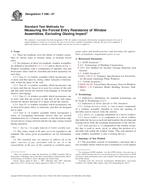Potrebujeme váš súhlas na využitie jednotlivých dát, aby sa vám okrem iného mohli ukazovať informácie týkajúce sa vašich záujmov. Súhlas udelíte kliknutím na tlačidlo „OK“.
ASTM F588-07
Standard Test Methods for Measuring the Forced Entry Resistance of Window Assemblies, Excluding Glazing Impact
Automaticky preložený názov:
Štandardné testovacie metódy pre meranie násilnému vniknutiu Odolnosť okenných montážnych celkov , okrem Zasklenie Impact
NORMA vydaná dňa 1.4.2007
Informácie o norme:
Označenie normy: ASTM F588-07
Poznámka: NEPLATNÁ
Dátum vydania normy: 1.4.2007
Kód tovaru: NS-55791
Počet strán: 13
Približná hmotnosť: 39 g (0.09 libier)
Krajina: Americká technická norma
Kategória: Technické normy ASTM
Anotácia textu normy ASTM F588-07 :
Keywords:
fenestration, forced entry resistance, laboratory method, windows, ICS Number Code 13.310 (Protection against crime), 91.060.50 (Doors and windows)
Doplňujúce informácie
| Significance and Use | ||||||||
|
These test methods are intended to establish a measure of resistance for window assemblies subjected to attacks (other than impacting glazing materials) by unskilled or opportunistic burglars. Resistance to higher levels of force generated by skilled burglary attack requires methods such as alarms, communication, or apprehension systems, or special security glazing materials more sophisticated than those evaluated by these test methods. Entry through a window assembly can be accomplished by impacting the glazing materials. This method does not evaluate glazing materials for breakage. Other standards must be used to evaluate forced entry by impacting the glazing. Acceptance criteria for performance levels are a matter for authorities having specific jurisdiction to establish. Suggested guidelines are found in Annex A1. |
||||||||
| 1. Scope | ||||||||
|
1.1 These test methods cover the ability of window assemblies of various types to restrain, delay, or frustrate forced entry. 1.2 For purposes of these test methods, window assemblies are defined as described in 1.2.1-1.2.5 and as shown in Fig. 1. Window assemblies with a combination of operable sash and fixed panes (lites) shall be classified and tested separately for each type. 1.2.1 Type A—A window assembly which incorporates one or more sash that open by sliding, either vertically or horizontally within the plane of the wall. 1.2.2 Type B—A window assembly which incorporates one or more sash that are hinged at or near two corners of the sash and that open toward the exterior (outswinging) or toward the interior (inswinging). 1.2.3 Type C—A window assembly which incorporates one or more sash that are pivoted so that part of the sash opens toward the interior and part of it opens toward the exterior. 1.2.4 Type D—A window assembly which incorporates one or more fixed panes (lites) or stationary sash that are designed not to open. 1.2.5 Type E—A window assembly which incorporates a series of overlapping horizontal louvers that are pivoted simultaneously by a common actuator so that the bottom edge of each louver swings outward and the top edge swings inward during operation. Note 1—See Fig. 1 for graphic depiction of window assembly types. 1.3 The values stated in SI units are to be regarded as the standard. The values given in parentheses are for information only. 1.4 This standard does not purport to address all of the safety concerns, if any, associated with its use. It is the responsibility of the user of this standard to establish appropriate safety and health practices and determine the applicability of regulatory requirements prior to use. |
||||||||
| 2. Referenced Documents | ||||||||
|




 Cookies
Cookies
